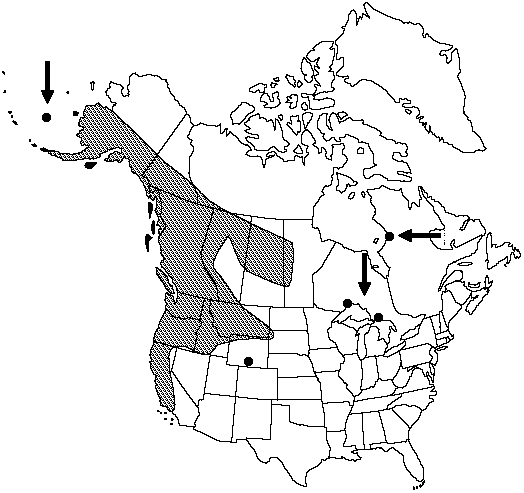Difference between revisions of "Athyrium filix-femina var. cyclosorum"
Dist. Crypt. Vasc. Ross. 41. 1845.
FNA>Volume Importer |
imported>Volume Importer |
||
| (7 intermediate revisions by 2 users not shown) | |||
| Line 8: | Line 8: | ||
}} | }} | ||
|common_names=Northwestern lady fern | |common_names=Northwestern lady fern | ||
| − | | | + | |special_status={{Treatment/ID/Special_status |
| − | | | + | |code=E |
| − | | | + | |label=Endemic |
}} | }} | ||
| + | |basionyms= | ||
|synonyms={{Treatment/ID/Synonym | |synonyms={{Treatment/ID/Synonym | ||
|name=Athyrium alpestre var. cyclosorum | |name=Athyrium alpestre var. cyclosorum | ||
|authority=(Ruprecht) T. Moore | |authority=(Ruprecht) T. Moore | ||
| − | }}{{Treatment/ID/Synonym | + | |rank=variety |
| + | }} {{Treatment/ID/Synonym | ||
| + | |name=Athyrium filix-femina subsp. cyclosorum | ||
| + | |authority=(Ruprecht) C. Christensen | ||
| + | |rank=subspecies | ||
| + | }} {{Treatment/ID/Synonym | ||
|name=Athyrium filix-femina var. sitchense | |name=Athyrium filix-femina var. sitchense | ||
|authority=Ruprecht | |authority=Ruprecht | ||
| + | |rank=variety | ||
}} | }} | ||
|hierarchy=Dryopteridaceae;Athyrium;Athyrium filix-femina;Athyrium filix-femina var. cyclosorum | |hierarchy=Dryopteridaceae;Athyrium;Athyrium filix-femina;Athyrium filix-femina var. cyclosorum | ||
| Line 26: | Line 33: | ||
}}<!-- | }}<!-- | ||
| − | --><span class="statement" id="st- | + | --><span class="statement" id="st-undefined" data-properties=""><b>Petiole </b>15–45(–60) cm, base densely scaly; scales brown or dark brown, lanceolate or ovate-lanceolate, (7–)10–20 × (1–)2–5 mm, ± crisped. <b>Blade</b> elliptic to oblanceolate, 1–2-pinnate-pinnatifid, 25–120 × 10–50 cm, gradually narrowed proximally, broadest at or just above middle, apex acuminate. <b>Pinnae</b> very short-stalked or sessile, linear-oblong or oblong, apex acuminate. <b>Pinnules</b> sessile, narrowly deltate or oblong-lanceolate, base basiscopically broadly cuneate, acroscopically truncate, ± auriculate, apex obtuse to ± acute. <b>Rachis</b>, costae, and costules glabrous or with scales or pale glands. <b>Sori</b> round to elliptic, hooked at distal end, or horseshoe-shaped, medial to supramedial; indusia long-ciliate with nonglandular marginal hairs as long as or longer than width of indusia. <b>Spores</b> yellow. <b>2n</b> = 80.</span><!-- |
-->{{Treatment/Body | -->{{Treatment/Body | ||
| Line 32: | Line 39: | ||
|elevation=10–1600 m | |elevation=10–1600 m | ||
|distribution=Alta.;B.C.;Man.;N.W.T.;Ont.;Que.;Sask.;Yukon;Alaska;Calif.;Idaho;Mont.;Oreg.;S.Dak.;Wash.;Wyo. | |distribution=Alta.;B.C.;Man.;N.W.T.;Ont.;Que.;Sask.;Yukon;Alaska;Calif.;Idaho;Mont.;Oreg.;S.Dak.;Wash.;Wyo. | ||
| − | |discussion=<p>Athyrium filix-femina var. cyclosorum is most similar to the European var. filix-femina; it differs in having broader, nearly equilateral pinnules and medial to supramedial sori. The variety is distributed in northwestern North America with disjunct populations in northwestern Quebec and Ontario.</p> | + | |discussion=<p><i>Athyrium filix-femina </i>var.<i> cyclosorum</i> is most similar to the European var. filix-femina; it differs in having broader, nearly equilateral pinnules and medial to supramedial sori. The variety is distributed in northwestern North America with disjunct populations in northwestern Quebec and Ontario.</p> |
|tables= | |tables= | ||
|references= | |references= | ||
| Line 41: | Line 48: | ||
-->{{#Taxon: | -->{{#Taxon: | ||
name=Athyrium filix-femina var. cyclosorum | name=Athyrium filix-femina var. cyclosorum | ||
| − | |||
|authority=Ruprecht | |authority=Ruprecht | ||
|rank=variety | |rank=variety | ||
|parent rank=species | |parent rank=species | ||
| − | |synonyms=Athyrium alpestre var. cyclosorum;Athyrium filix-femina var. sitchense | + | |synonyms=Athyrium alpestre var. cyclosorum;Athyrium filix-femina subsp. cyclosorum;Athyrium filix-femina var. sitchense |
| − | |basionyms= | + | |basionyms= |
|family=Dryopteridaceae | |family=Dryopteridaceae | ||
|habitat=Moist woods, swamps, streambanks | |habitat=Moist woods, swamps, streambanks | ||
| Line 54: | Line 60: | ||
|publication title=Dist. Crypt. Vasc. Ross. | |publication title=Dist. Crypt. Vasc. Ross. | ||
|publication year=1845 | |publication year=1845 | ||
| − | |special status= | + | |special status=Endemic |
| − | |source xml=https:// | + | |source xml=https://bitbucket.org/aafc-mbb/fna-data-curation/src/2e0870ddd59836b60bcf96646a41e87ea5a5943a/coarse_grained_fna_xml/V2/V2_87.xml |
|genus=Athyrium | |genus=Athyrium | ||
|species=Athyrium filix-femina | |species=Athyrium filix-femina | ||
|variety=Athyrium filix-femina var. cyclosorum | |variety=Athyrium filix-femina var. cyclosorum | ||
| − | |||
| − | |||
| − | |||
| − | |||
| − | |||
| − | |||
| − | |||
| − | |||
| − | |||
| − | |||
| − | |||
| − | |||
| − | |||
| − | |||
| − | |||
| − | |||
| − | |||
| − | |||
| − | |||
| − | |||
| − | |||
| − | |||
| − | |||
| − | |||
| − | |||
| − | |||
| − | |||
| − | |||
| − | |||
| − | |||
| − | |||
}}<!-- | }}<!-- | ||
-->[[Category:Treatment]][[Category:Athyrium filix-femina]] | -->[[Category:Treatment]][[Category:Athyrium filix-femina]] | ||
Latest revision as of 20:25, 5 November 2020
Petiole 15–45(–60) cm, base densely scaly; scales brown or dark brown, lanceolate or ovate-lanceolate, (7–)10–20 × (1–)2–5 mm, ± crisped. Blade elliptic to oblanceolate, 1–2-pinnate-pinnatifid, 25–120 × 10–50 cm, gradually narrowed proximally, broadest at or just above middle, apex acuminate. Pinnae very short-stalked or sessile, linear-oblong or oblong, apex acuminate. Pinnules sessile, narrowly deltate or oblong-lanceolate, base basiscopically broadly cuneate, acroscopically truncate, ± auriculate, apex obtuse to ± acute. Rachis, costae, and costules glabrous or with scales or pale glands. Sori round to elliptic, hooked at distal end, or horseshoe-shaped, medial to supramedial; indusia long-ciliate with nonglandular marginal hairs as long as or longer than width of indusia. Spores yellow. 2n = 80.
Habitat: Moist woods, swamps, streambanks
Elevation: 10–1600 m
Distribution

Alta., B.C., Man., N.W.T., Ont., Que., Sask., Yukon, Alaska, Calif., Idaho, Mont., Oreg., S.Dak., Wash., Wyo.
Discussion
Athyrium filix-femina var. cyclosorum is most similar to the European var. filix-femina; it differs in having broader, nearly equilateral pinnules and medial to supramedial sori. The variety is distributed in northwestern North America with disjunct populations in northwestern Quebec and Ontario.
Selected References
None.